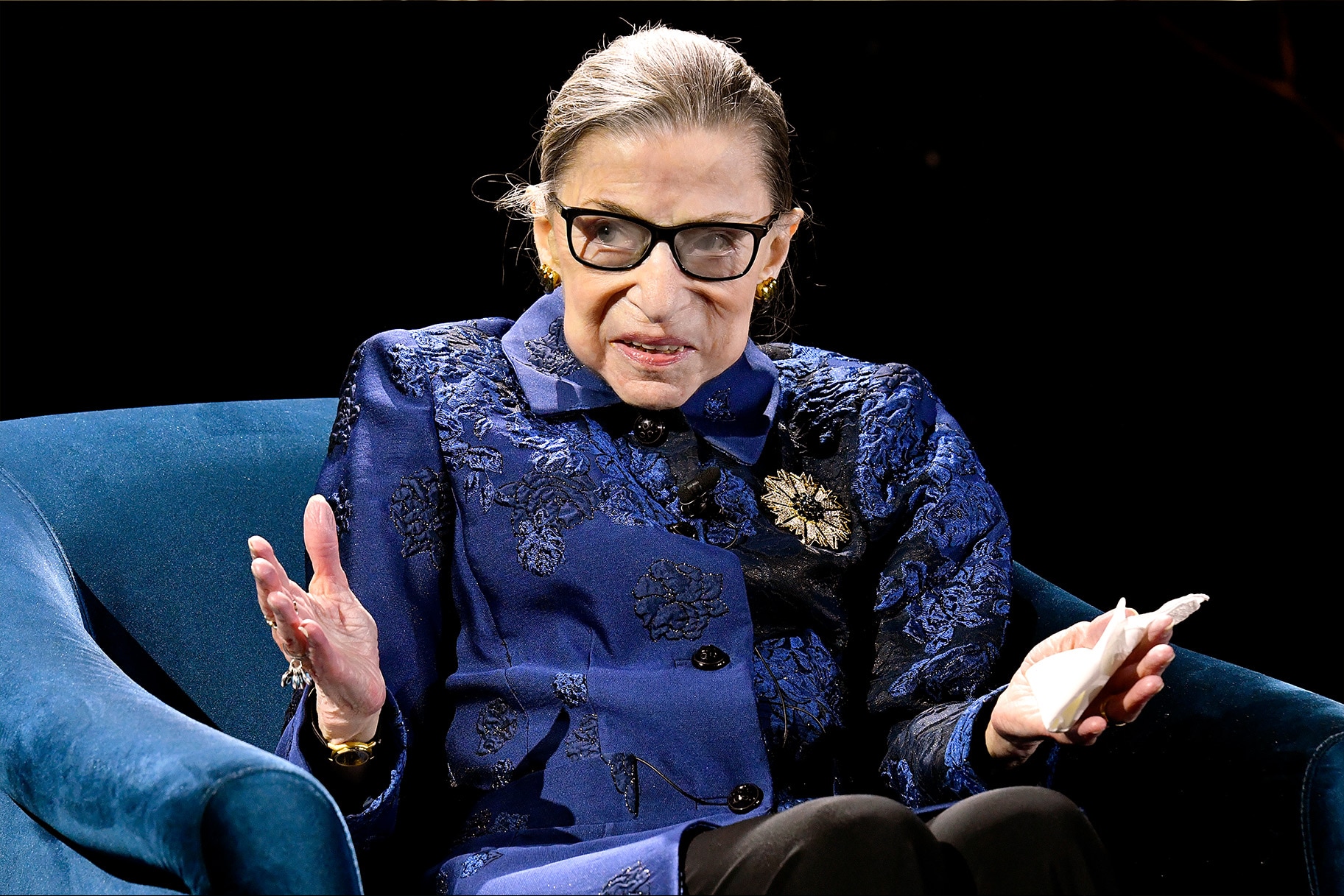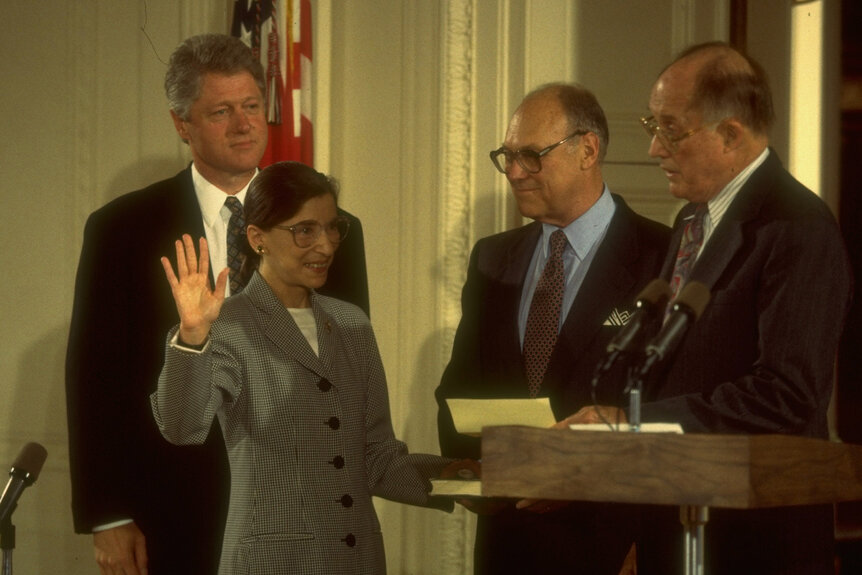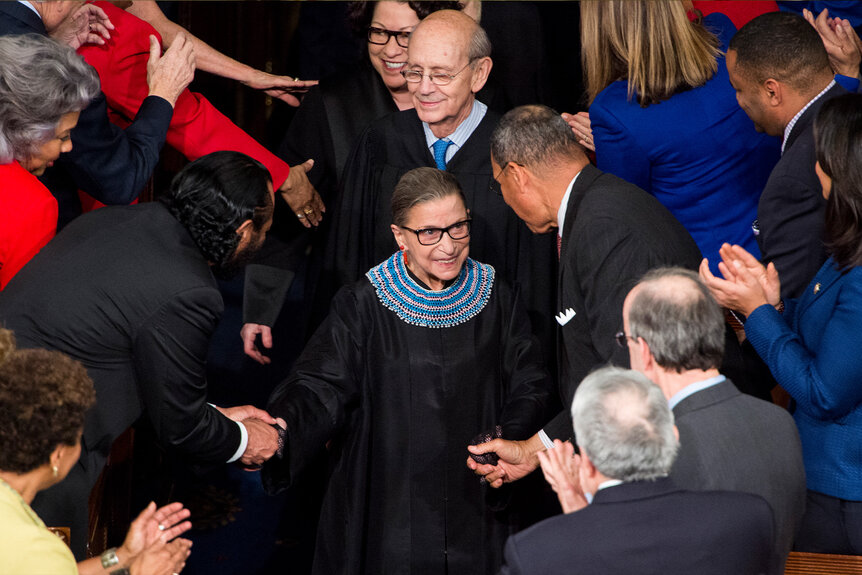Create a free profile to get unlimited access to exclusive videos, breaking news, sweepstakes, and more!
It’s Been 30 Years Since Ruth Bader Ginsburg’s Historic Supreme Court Justice Appointment – And She’s Still Being Celebrated
This summer marks 30 years since Ruth Bader Ginsburg was sworn in as an Associate Supreme Court Justice, making history as the first Jewish woman to serve on the court and only the second woman.

This summer marks 30 years since Ruth Bader Ginsburg was sworn in as an Associate Supreme Court Justice, making history as the first Jewish woman to serve on the court and only the second woman.
The Brooklyn-born trailblazer would have turned 90 this March, smack in the middle of Women's History Month. And though she died a few years before what would have been a milestone birthday and work anniversary, she’s still being celebrated by those she inspired.
New York Gov. Kathy Hochul recently announced plans to honor Ginsburg this spring with a portrait carving of the justice that will take a permanent spot in the New York State Capitol.
"When Ruth Bader Ginsburg was asked when there would be enough women on the U.S. Supreme Court, she famously replied, 'When there are nine,'" Governor Hochul said in a statement. "By carving her portrait into the Capitol, we are both honoring Justice Ginsburg's legacy as a trailblazer for justice and gender equality, and also celebrating New York's history as the birthplace of the women's rights movement."
Meanwhile, a play, “All Things Equal: The Life & Trials of Ruth Bader Ginsburg,” is making its way around the country, with upcoming stops including Bloomington, Illinois on April 20, and Jamestown, New York on May 6.
Michelle Azar stars as Ginsburg in this one-person play written by Tony-winner Rupert Holmes.
“Sometimes I am speaking directly to the audience, and we’re in this interchange together about the events that have happened in history,” Azar recently told Ohio’s The Morning Journal ahead of a March 21 show in Elyria. “We all travel back together.”
Ginsburg was born Joan Ruth Bader on March 15, 1933 in Brooklyn to an immigrant father and native New Yorker mom. Her Jewish family stressed education and she went on to get a bachelor’s degree from Cornell University in 1954, earning high honors in her government coursework, according to the National Women’s History Museum,
She got married to Martin D. Ginsburg that same year, a lawyer who she remained married to until his death in 2010 at age 78. They had two children together, a daughter born in 1955 and a son born in 1965.
After Cornell, Ginsburg went to Harvard Law School, where she was one of just nine women in her class of 500 students. The women were banned from accessing certain areas of the library, according to the National Women’s History Museum, and were called on in class for “comic relief.”
At Harvard, a dean asked the female law students what it felt like taking up spots that could have gone to men who deserved to be there, according to Oyez, an unofficial archive of the Supreme Court. Despite the gender discrimination, Ginsburg stuck it out and succeeded academically, earning a spot with the Harvard Law Review.
She eventually transferred to Columbia Law School for her last year in 1958, and made the law review there too, becoming the first woman to earn the honor at two major law schools. She graduated at the top of her class, Oyez states.
Her husband, Martin, who had also attended Harvard Law School, got sick with testicular cancer during his third year.
While he underwent surgery and received radiation treatment, Ginsburg balanced her coursework with taking care of her husband and their preschool-aged daughter.
She even went to Martin’s lessons, and typed up his papers that he dictated, until his recovery.
While Martin scored a job at a New York law firm upon graduation, Ginsburg had a tougher time landing one, despite all of her achievements.
Only two firms she applied to invited her in for a visit, and neither one of them offered her a job, according to a 1993 New York Times article published a few days after President Bill Clinton nominated her as an associate justice of the Supreme Court to fill the seat Byron White was leaving open with his retirement.
"In the Fifties, the traditional law firms were just beginning to turn around on hiring Jews," Ginsburg later wrote, according to that Times story. "But to be a woman, a Jew and a mother to boot — that combination was a bit too much."
While initially trying to get a judicial clerkship, one justice reportedly said, "Does she wear skirts? I can't stand girls in pants," the Times reported. She didn’t get a job at that place, but eventually found a gig as a law clerk for the Judge of the United States District Court for the Southern District of New York in 1959, where she remained for two years.
After that, she got a job as a research associate for the Columbia Law School Project on International Procedure, according to the National Women’s History Museum, becoming the associate director.
She then worked as a professor of law at Rutgers University School of Law, from 1963 through 1972. Ginsburg started getting involved with the American Civil Liberties Union around the same time and contributed to founding that organization’s Women’s Rights Project in 1971.
The following year, she took a teaching job at Columbia Law School, where she became the first woman to receive tenure. While working as a professor there, she also acted as the general counsel for the ACLU from 1973 to 1980, and then served on its National Board of Directors from 1974 through 1980.
In 1980, she was appointed to the United States Court of Appeals for the District of Columbia Circuit by President Jimmy Carter, doing that job for 13 years, until Clinton nominated her to the Supreme Court.
She was seated on Aug. 10, 1993, and remained there until her death at age 87 on Sept. 18, 2020, caused by complications of metastatic pancreatic cancer.
Her years as a Supreme Court Justice were marked by her advocacy for women’s rights and gender equality, notably writing the court’s opinion on the United States v. Virginia case, which decided that women could not be denied admission to the previously male-only Virginia Military Institute.
She also dissented against the court’s Ledbetter v. Goodyear Tire & Rubber Co. ruling, which denied a woman’s gender pay discrimination claim. And she worked closely with President Barack Obama on the Lilly Ledbetter Fair Pay Act of 2009, which works to fight pay disparities.
Ginsburg was the only female justice on the Supreme Court between the period that Sandra Day O'Connor (the first woman to serve on the court) retired in 2006, and Sonia Sotomayor was appointed in 2009.
Some criticized Ginsburg’s decision not to retire during Obama’s presidency, while Democrats controlled the Senate. Her September, 2020 death, while President Donald Trump was in office, allowed him and a Republican Senate to replace her with Amy Comey Barrett, who leans far more conservative.
Azar, the actress who plays Ginsburg onstage in the national tour of “All Things Equal,” told The Morning Journal that the justice’s decision is addressed in the play.
She told the newspaper that the Ginsburg she plays says something like, “I understand and respect that you would be upset with me.”
Ginsburg’s portrait carving at the New York State Capitol will be the first new carving added to the Great Western Staircase since it was completed in 1898 and only the seventh woman featured in the staircase gallery.
Its location on the second floor will put it on a level where only men have been featured up until now. It’ll be placed just above John Jay, the Supreme Court's first chief justice and the only other Supreme Court justice to have a portrait on the staircase.
Ginsburg was also honored on Friday at the high court, where she was remembered in ceremonies by some of those who worked for her, including judges, professors, and those who served as law clerks for her.




